No matter how many photos you’ve seen of the Grand Canyon, standing at the rim’s edge for the first time will take your breath away—especially if you’re there at sunset, as the fading light paints shades of rose, violet, and gold onto the ancient rocks. But planning a trip to the Grand Canyon requires more than just booking a hotel and packing your camera.
Planning a Trip to the Grand Canyon
When should you travel to avoid the heaviest crowds and the most intense heat? Should you visit the North Rim or the South Rim? Where’s the best place to stay? For answers to these questions and more, read the following tips for planning a trip to the Grand Canyon.
South Rim vs. North Rim vs. Grand Canyon West
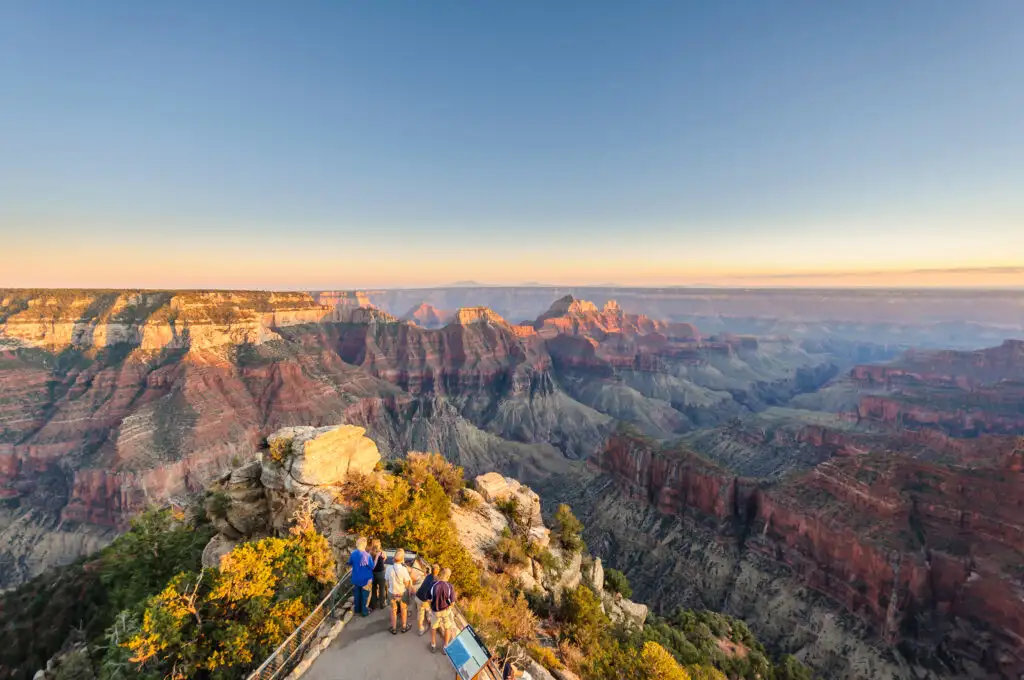
Grand Canyon National Park is split into two sections: the South Rim and the North Rim, located more than four hours apart by car. Then there’s Grand Canyon West, located on the Hualapai Native American Reservation, four hours from the South Rim and nearly seven hours from the North Rim. Where should you go if you’re planning a trip to the Grand Canyon and your time is limited?
The South Rim is the most visited part of the Grand Canyon for a reason. It has more viewpoints than the North Rim, with more expansive views of the canyon’s depth and a broader range of lodging options and other visitor services. It also has plenty of hiking trails and activities like river rafting and mule rides. This is the place to go if you’re looking for classic Grand Canyon views.
Popular with hikers and photographers, the North Rim is the South Rim’s quieter, more heavily forested cousin. While the views may be less spectacular, many travelers prefer the North Rim for its undisturbed wildlife and pristine trails. Since the North Rim is at a higher elevation, it gets significantly more snow in winter than the South Rim and is closed seasonally to all vehicles between December 1 and May 14. No visitor services are available during this time.
The key draw at Grand Canyon West is the Skywalk, a glass bridge that extends 70 feet over the canyon for dizzying views on all sides—including right under your feet. (Important note: The Skywalk does not permit cameras or phones. Professional photos are available for sale.) This isn’t the best bet for avid hikers, as there are only two (relatively easy) trails here. Still, other activities include zip-lining, pontoon boat rides, and whitewater rafting. Grand Canyon West is the closest part of the canyon to Las Vegas, making it a convenient, though long, day trip.
Note that because Grand Canyon West is located on Native American land, it requires a separate entry fee from the North and South Rims, which are administered by the National Park Service.
When to Visit the Grand Canyon
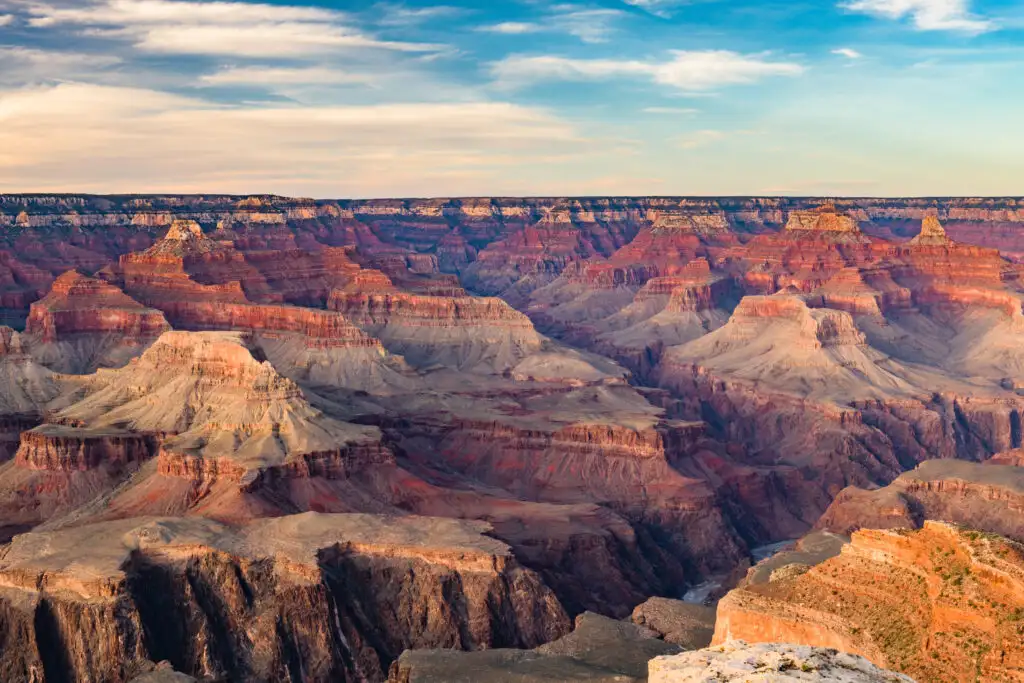
When planning a trip to the Grand Canyon, consider visiting the South Rim any time other than summer—especially if you’re hoping to hike down to the bottom of the canyon, where temperatures can soar above 100 degrees Fahrenheit in July and August. Summer is also the busiest time of year; lodging in the park is expensive and sells out quickly, and viewpoints along the rim can be jammed with crowds.
The South Rim is open all year round, and you’ll find pleasant temperatures and smaller crowds in the shoulder seasons (spring and fall). Even a winter visit can be rewarding; bundle up and enjoy the sight of the canyon dusted with snow.
Thanks to its higher altitude, the North Rim has a cooler climate and is closed between mid-October and mid-May. Fortunately, this part of the park sees fewer visitors and isn’t usually crowded, even during the summer high season. Consider visiting in the fall, when the Kaibab National Forest erupts in vibrant colors.
Grand Canyon West is open year-round and less crowded outside the summer months.
Getting to the Grand Canyon
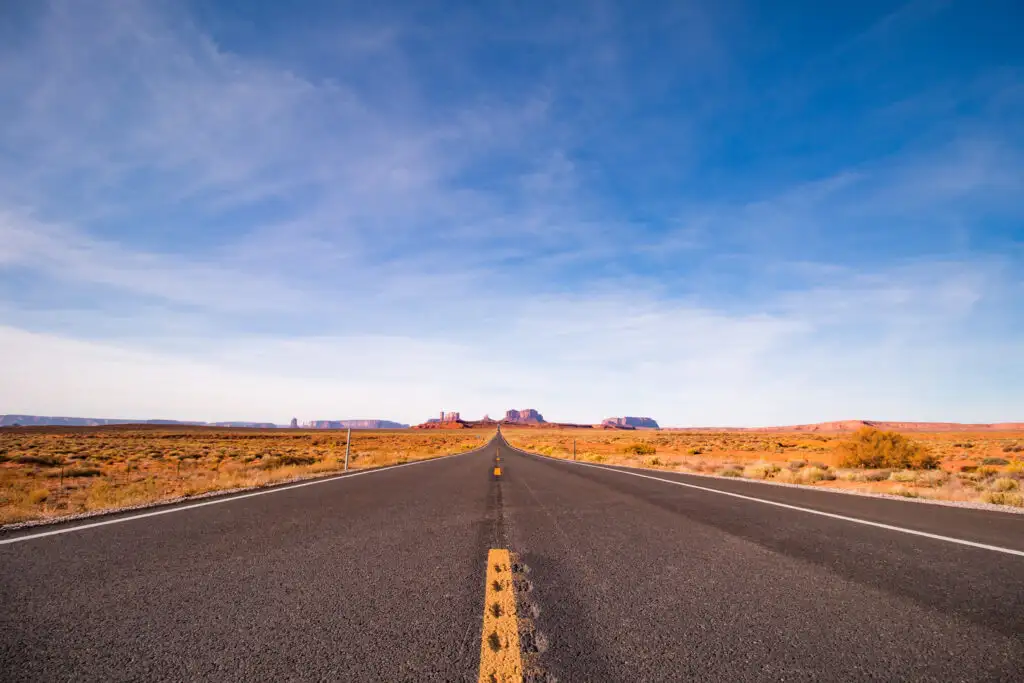
Most visitors to the Grand Canyon fly into Las Vegas or Phoenix. There’s also a small airport in Flagstaff, just an hour from the South Rim, and some North Rim travelers fly into Salt Lake City. No matter where you land, you’ll need to rent a car, as public transit is extremely limited in this part of the U.S.
Once you arrive at the Grand Canyon, you might need to park your car and take a shuttle bus to get around. Grand Canyon West is closed to private vehicles and operates a hop-on, hop-off shuttle around the park, while certain parts of the South Rim are only accessible by bus. A shuttle service makes the 4.5-hour trip between the North and South Rims; it’s convenient for rim-to-rim hikers. The North Rim is fully open to private vehicles except during the winter.
One fun alternative way to arrive at the South Rim is via the Grand Canyon Railway, which runs from Williams, Arizona, into the heart of the park, allowing for a half-day of exploring before returning in the afternoon.
Grand Canyon Lodging
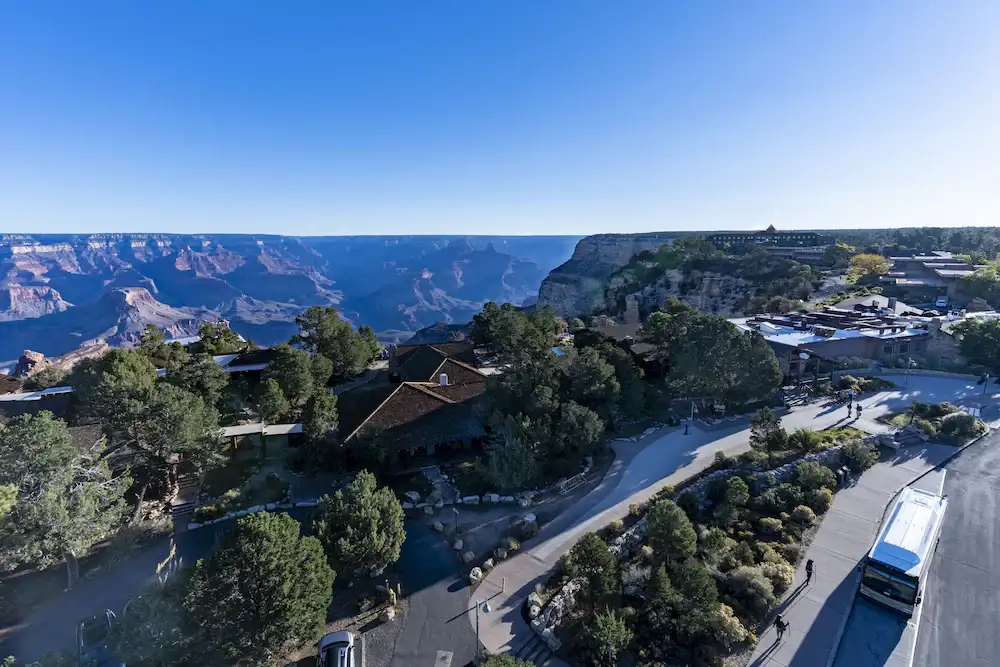
The most convenient Grand Canyon lodging options are within the national park or Grand Canyon West rather than in nearby towns, but these options tend to book up quickly—sometimes almost a year in advance. When planning a trip to the Canyon, reserve your accommodations first. Staying within the national park will save you valuable time waiting to get in the entrance gates each day.
The South Rim section of Grand Canyon National Park is home to half a dozen lodges, including the venerable El Tovar, which dates back to 1905 and has hosted former presidents Theodore Roosevelt and Bill Clinton. Another option is the Bright Angel Lodge, situated at the top of the park’s most popular trail. There’s also an RV park near the main visitor center and two campgrounds.
If you can’t find lodging within the South Rim section of the park, there’s a handful of options in nearby Tusayan, as well as dozens of hotels (mostly chain motels) in Williams and Flagstaff, each a little more than an hour from the park entrance gates.
The North Rim has just two places to stay inside the park: the Grand Canyon Lodge, which offers motel rooms and cabins, and the North Rim Campground. If these are booked, consider the Jacob Lake Inn, 45 miles away, or head farther afield to Kanab, Utah, or Page, Arizona.
The most unique place to stay at Grand Canyon National Park is Phantom Ranch, a group of cabins located on the canyon floor. The only ways to get there are to hike or ride a mule down, and you’ll need to win a lottery in order to reserve a room.
If you want to stay overnight within Grand Canyon West, you can book a cabin at Hualapai Ranch; each one features a front porch where you can relax and enjoy the desert views.
Grand Canyon Hikes
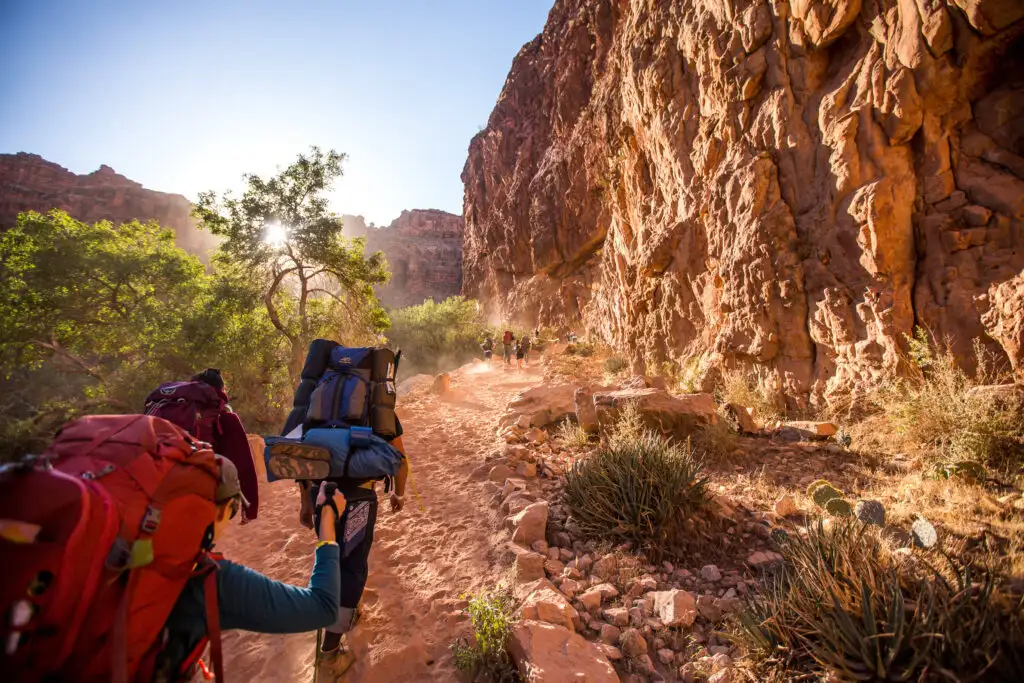
The simplest walk at Grand Canyon National Park is the Rim Trail, which stretches for 13—mostly flat—miles along the top of the South Rim. Much of it is paved and wheelchair-accessible, and you can enter and leave the path at any viewpoint.
If your fitness allows, try to hike at least part of the way into the Grand Canyon; you’ll get a completely different perspective than you do from the top.
The most popular South Rim trail into the canyon is the Bright Angel Trail, which is well-maintained and offers some shade along the way. Another good option is the South Kaibab Trail—it is a little steeper and has less shade but boasts slightly more dramatic views if you’re only doing part of the trail. While both of these trails go all the way to the bottom, you can easily transform each of them into a day hike by turning around at one of the mile markers and going back the way you came.
The North Rim offers a variety of day hikes ranging from less than a mile to about 10 miles round-trip. It’s possible to hike into the canyon from the North Rim on the North Kaibab Trail and back out via one of the trails on the South Rim (or vice versa); this is recommended only for fit, experienced hikers.
For information on all the trails listed above, see the day hiking information page on NPS.gov.
The National Park Service strongly recommends against hiking down to the river and back in a single day, even if you’re a veteran hiker. Instead, plan to overnight at Phantom Ranch or one of several backcountry campgrounds within the canyon, but know that reservations are required in advance.
Keep in mind that it usually takes twice as long to come back up the trail as it does to go down and temperatures at the bottom of the canyon can be up to 20 degrees higher than those at the top. Hundreds of hikers are rescued each year from the canyon due to dehydration, heat exhaustion, or injury.
Grand Canyon West offers just two hiking trails, one easy and one moderate, and neither goes into the canyon.
One intriguing Grand Canyon hike to consider is the 10-mile (each way) track to Havasu Falls, the famous turquoise cascade you’ve probably seen on your Instagram feed. It’s located on Native American land between the South Rim and Grand Canyon West. Reservations are required (and limited). To learn more, see the NPS website.
Mule Rides, Rafting Trips, and Helicopter Tours
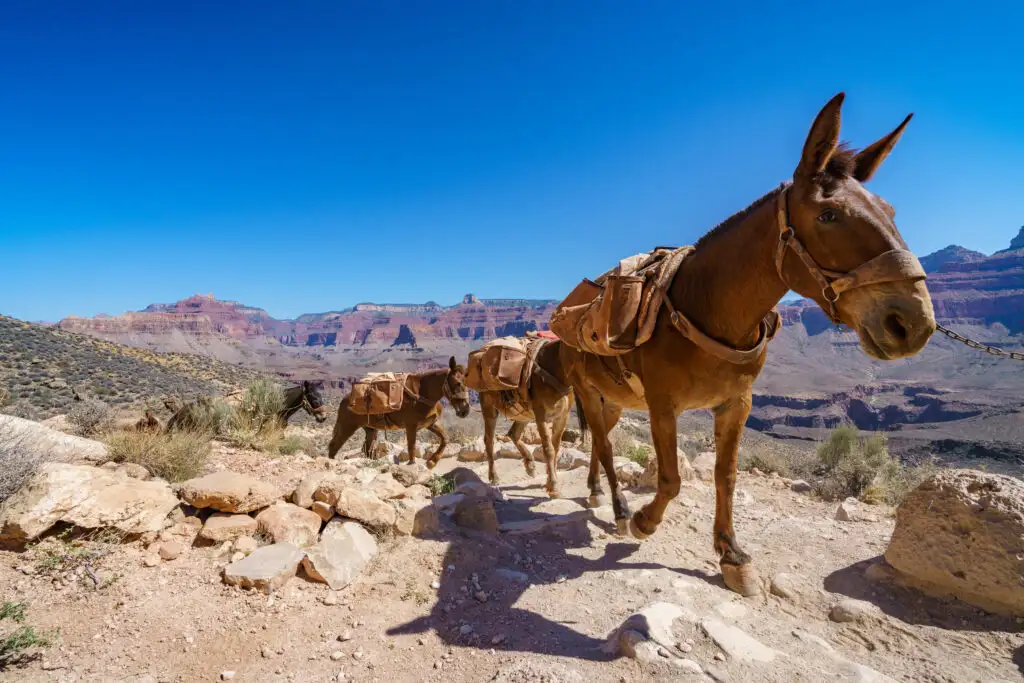
When planning a trip to the Grand Canyon, don’t forget about other activities besides hiking, like riding a mule into the canyon. (Why a mule? They’re more sure-footed than horses.)
From the South Rim, you can ride a mule to the Colorado River and spend a night or two at Phantom Ranch or take a shorter two-hour ride along the rim. You can take one- or three-hour rides from the North Rim along the rim or part of the way into the canyon—book as far in advance as possible to guarantee yourself a spot.
Dreaming of rafting the Colorado River? You can take a guided trip in the national park with options from a half-day to more than two weeks, or plan your own trip with a permit from the National Park Service. To plan a one- or two-day rafting trip at Grand Canyon West, visit GrandCanyonWest.com.
Finally, one of the most incredible ways to view the Grand Canyon is from the air. Numerous companies operate helicopter tours over the canyon, including Grand Canyon Helicopters and Papillon.
General Grand Canyon Travel Tips
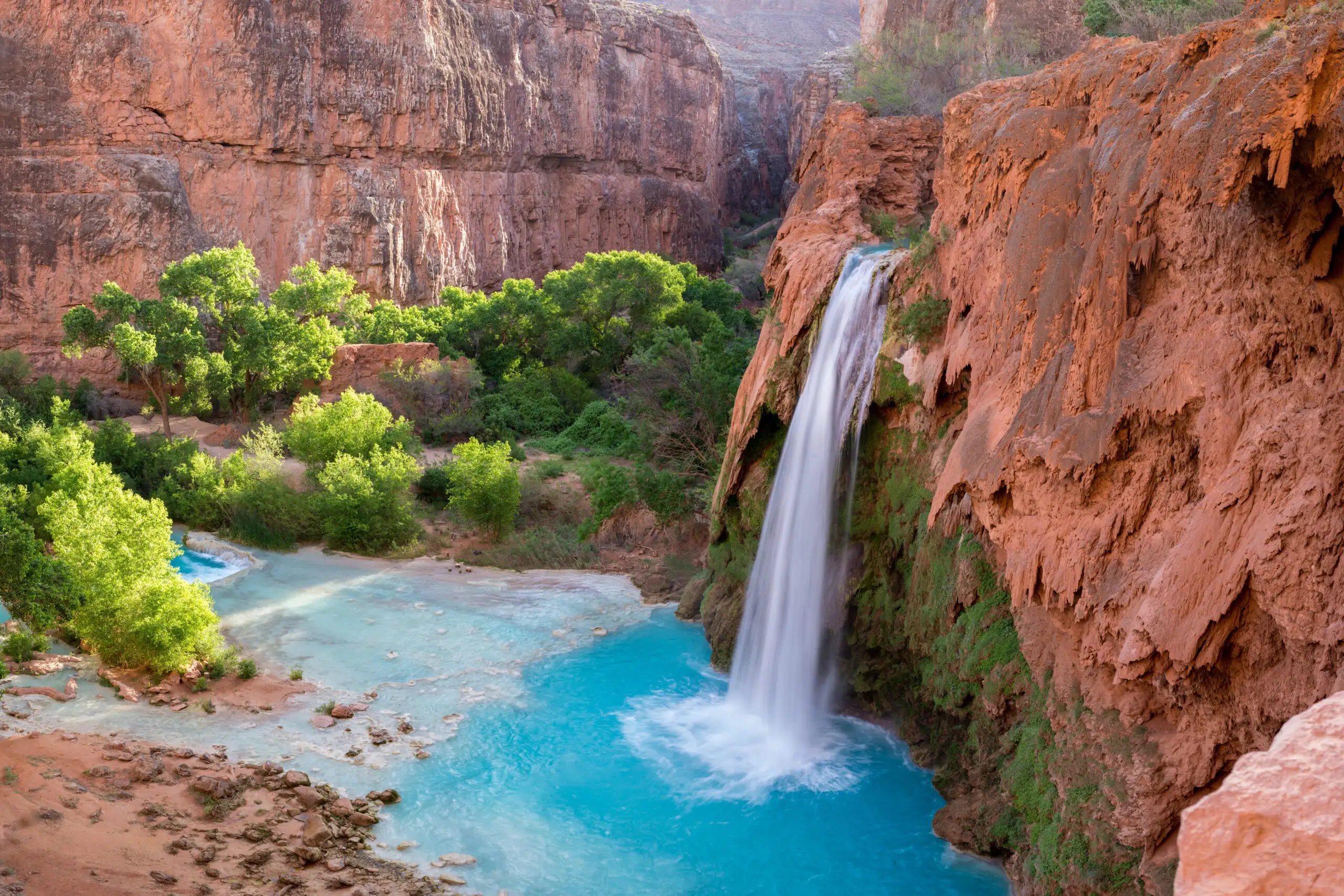
Stop by the visitor center as soon as you arrive—especially if you have limited time. Park rangers can help design an itinerary to maximize your visit, suggest hikes to suit your fitness level, and recommend the best sunrise and/or sunset viewpoints.
The desert heat can be deadly, so hikers should pack plenty of water and salty snacks. Bring a reusable bottle that you can fill up at water stations located throughout the national park. Start hiking early in the morning to avoid the midday sun. If you get a headache or start to feel dizzy or sick to your stomach, stop to rest and rehydrate.
The South Rim is located at 7,000 feet above sea level, and the North Rim is at nearly 8,300 feet. Some travelers may experience fatigue, headaches, or other symptoms of altitude sickness.
Stick to the trail. Not only does this protect the landscape, but it also protects you. Numerous tourists have died after falling from the rim of the canyon.
The most crowded viewpoints at the South Rim are those nearest the parking lots and bus stops. To avoid getting a hundred other people in every photo, walk along the Rim Trail in either direction. Often, you can snap great shots along the trail or find your way to a less congested viewpoint.
Follow Sarah Schlichter on Twitter @TravelEditor for more travel tips and inspiration.
Editor’s note: This story was originally published in 2017. It has been updated to reflect the most current information. Some of the links featured in this story are affiliate links, and SmarterTravel may collect a commission (at no cost to you) if you shop through them.
You Might Also Like:
• The Best Frequent Flier Programs for 2025• Bike Safety Tips: How to Stay Safe and Comfortable While Riding
• How to Stay Sane When Planning a Trip with Friends
• International Car Rental Tips You Need to Know
• 14 Tips for Choosing the Right Group Tour
We hand-pick everything we recommend and select items through testing and reviews. Some products are sent to us free of charge with no incentive to offer a favorable review. We offer our unbiased opinions and do not accept compensation to review products. All items are in stock and prices are accurate at the time of publication. If you buy something through our links, we may earn a commission.
Related
Top Fares From Wichita, KS
Today's Top Travel Deals
Brought to you by ShermansTravel
Shop and Save with Country Inns...
Patricia Magaña
 Hotel & Lodging Deals
Hotel & Lodging Deals
$229 -- Chicago: Discounted Rates and...
Francesca Miele
 Hotel & Lodging Deals
$229+
Hotel & Lodging Deals
$229+
$188 -- Honolulu: Save on Oceanview...
Abigail Lamay
 Hotel & Lodging Deals
$188+
Hotel & Lodging Deals
$188+







